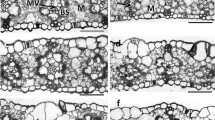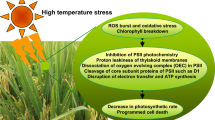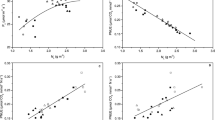Abstract
Miscanthus × giganteus (Greef & Deuter ex Hodkinson & Renvoize) is unique among C4 species in its remarkable ability to maintain high photosynthetic productivity at low temperature, by contrast to the related C4 NADP-malic enzyme-type species Zea mays L. In order to determine the in vivo physiological basis of this difference in photosynthesis, water vapor and CO2 exchange and modulated chlorophyll fluorescence were simultaneously monitored on attached leaf segments from plants grown and measured at 25/20°C or 14/11°C (day/night temperature). Analysis of the response of photosynthesis to internal CO2 concentration suggested that ribulose bisphosphate carboxylase/oxygenase (Rubisco) and/or pyruvate orthophosphate dikinase (PPDK) play a more important role in determining the response to low temperature than does phosphoenolpyruvate carboxylase (PEPc). For both species at both temperatures, the linear relationship between operating efficiency of whole-chain electron transport through photosystem II (ΦPSII) and the efficiency of CO2 assimilation (ΦCO2) was unchanged and had a zero intercept, suggesting the absence of non-photosynthetic electron sinks. The major limitation at low temperature could not be solely at Rubisco or at any other point in the Calvin cycle, since this would have increased leakage of CO2 to the mesophyll and increased ΦPSII/ΦCO2. This in vivo analysis suggested that maintenance of high photosynthetic rates in M. × giganteus at low temperature, in contrast to Z. mays, is most likely the result of different properties of Rubisco and/or PPDK, reduced susceptibility to photoinhibition, and the ability to maintain high levels of leaf absorptance during growth at low temperature.




Similar content being viewed by others
References
Aguilera C, Stirling CM, Long SP (1999) Genotypic variation within Zea mays for susceptibility to and rate of recovery from chill-induced photoinhibition of photosynthesis. Physiol Plant 106:429–436
Andrews JR, Fryer MJ, Baker NR (1995) Characterization of chilling effects on photosynthetic performance of maize crops during early-season growth using chlorophyll fluorescence. J Exp Bot 46:1195–1203
Asada K (1999) The water-water cycle in chloroplasts: scavenging of active oxygens and dissipation of excess photons. Annu Rev Plant Physiol Plant Mol Biol 50:601–639
Badger MR, Von Caemmerer S, Ruuska S, Nakano H (2000) Electron flow to oxygen in higher plants and algae: rates and control of direct photoreduction (Mehler reaction) and rubisco oxygenase. Philos Trans R Soc Lond B Biol Sci 355:1433–1446
Baker NR, Long SP (1988) Photosynthesis and temperature, with particular reference to effects on quantum yield. In: Long SP, Woodward FI (eds) Plants and temperature: Society for Experimental Biology Symposium No. XXXXII. Company of Biologists, Cambridge, pp 347–375
Baker NR, Bradbury M, Farage PK, Ireland CR, Long SP (1989) Measurements of the quantum yield of carbon assimilation and chlorophyll fluorescence for assessment of photosynthetic performance of crops in the field. Philos Trans R Soc Lond B Biol Sci 323:295–308
Baker NR, Nie G-Y, Ortizlopez A, Ort DR, Long SP (1990) Analysis of chill-induced depressions of photosynthesis in maize. In: Baltscheffsky M (ed) Current research in photosynthesis, vol IV. Kluwer, Dordrecht, pp 565–572
Beale CV, Long SP (1995) Can perennial C4 grasses attain high efficiencies of radiant energy conversion in cool climates? Plant Cell Environ 18:641–650
Beale CV, Bint DA, Long SP (1996) Leaf photosynthesis in the C4-grass Miscanthus × giganteus, growing in the cool temperate climate of southern England. J Exp Bot 47:267–273
Bernacchi CJ, Singsaas EL, Pimentel C, Portis AR Jr, Long SP (2001) Improved temperature response functions for models of Rubisco-limited photosynthesis. Plant Cell Environ 24:253–259
Bullard MJ, Heath MC, Nixon PMI (1995) Shoot growth, radiation interception and dry matter production and partitioning during the establishment phase of Miscanthus sinensis ‘Giganteus’ grown at two densities in the U. K. Ann Appl Biol 126:365–378
Cavaco AM, Silva AB, Arrabaça MC (2003) Effects of long-term chilling on growth and photosynthesis of the C4 gramineae Paspalum dilatatum. Physiol Plant 119:87–96
Chinthapalli B, Murmu J, Raghavendra AS (2003) Dramatic difference in the responses of phosphoenolpyruvate carboxylase to temperature in leaves of C3 and C4 plants. J Exp Bot 54:707–714
Clifton-Brown JC, Long SP, Jørgensen U (2001) Miscanthus productivity. In: Jones MB, Walsh M (eds) Miscanthus for energy and fibre. James & James, London, pp 10–20
Collatz GJ, Ribascarbo M, Berry JA (1992) Coupled photosynthesis–stomatal conductance model for leaves of C4 plants. Aust J Plant Physiol 19:519–538
Dai ZY, Ku MSB, Edwards GE (1993) C4 photosynthesis—the CO2-concentrating mechanism and photorespiration. Plant Physiol 103:83–90
Dai Z, Ku MSB, Edwards GE (1996) Oxygen sensitivity of photosynthesis and photorespiration in different photosynthetic types in the genus Flaveria. Planta 198:563–571
Du Y-C, Nose A, Wasano K (1999) Effects of chilling temperature on photosynthetic rates, photosynthetic enzyme activities and metabolite levels in leaves of three sugarcane species. Plant Cell Environ 22:317–324
Edwards GE, Baker NR (1993) Can CO2 assimilation in maize leaves be predicted accurately from chlorophyll fluorescence analysis. Photosynth Res 37:89–102
Farquhar GD, Sharkey TD (1982) Stomatal conductance and photosynthesis. Annu Rev Plant Physiol 33:317–345
Fracheboud Y, Haldimann P, Leipner J, Stamp P (1999) Chlorophyll fluorescence as a selection tool for cold tolerance of photosynthesis in maize (Zea mays L.). J Exp Bot 50:1533–1540
Fryer MJ, Andrews JR, Oxborough K, Blowers DA, Baker NR (1998) Relationship between CO2 assimilation, photosynthetic electron transport, and active O2 metabolism in leaves of maize in the field during periods of low temperature. Plant Physiol 116:571–580
Furbank RT, Chitty JA, Jenkins CLD, Taylor WC, Trevanion SJ, von Caemmerer S, Ashton AR (1997) Genetic manipulation of key photosynthetic enzymes in the C4 plant Flaveria bidentis. Aust J Plant Physiol 24:477–485
Genty B, Briantais JM, Baker NR (1989) The relationship between the quantum yield of photosynthetic electron transport and quenching of chlorophyll fluorescence. Biochim Biophys Acta 990:87–92
Hodkinson TR, Renvoize SA (2001) Nomenclature of Miscanthus × giganteus (Poaceae). Kew Bull 56:759–760
Kingston-Smith AH, Harbinson J, WIlliams J, Foyer CH (1997) Effect of chilling on carbon assimilation, enzyme activation, and photosynthetic electron transport in the absence of photoinhibition in maize leaves. Plant Physiol 114:1039–1046
Kubien DS, von Caemmerer S, Furbank RT, Sage R (2003) C4 photosynthesis at low temperature. A study using transgenic plants with reduced amounts of rubisco. Plant Physiol 132:1577–1585
Laisk A, Edwards GE (1998) Oxygen and electron flow in C4 photosynthesis: Mehler reaction, photorespiration and CO2 concentration in the bundle sheath. Planta 205:632–645
Laisk A, Edwards GE (2000) A mathematical model of C4 photosynthesis: the mechanism of concentrating CO2 in NADP-malic enzyme type species. Photosynth Res 66:199–124
Lee AE, Staebler MA, Tollenaar M (2002) Genetic variation in physiological discriminators for cold tolerance—early autotrophic phase of maize development. Crop Sci 42:1919–1929
Leipner J, Fracheboud Y, Stamp P (1999) Effect of growing season on the photosynthetic apparatus and leaf antioxidative defenses in two maize genotypes of different chilling tolerance. Environ Exp Bot 42:129–139
Leipner J, Basilidès A, Stamp P, Fracheboud Y (2000) Hardly increased oxidative stress after exposure to low temperature in chilling-acclimated and non-acclimated maize leaves. Plant Biol 2:243–252
Long SP (1983) C4 photosynthesis at low temperatures. Plant Cell Environ 6:345–363
Long SP (1999) Environmental responses. In: Sage RF, Monson RK (eds) C4 plant biology. Academic Press, San Diego, pp 215–249
Long SP, Beale CV (2001) Resource capture by Miscanthus. In: Jones MB, Walsh M (eds) Miscanthus for energy and fibre. James & James, London, pp 10–20
Long SP, Bernacchi CJ (2003) Gas exchange measurements, what can they tell us about the underlying limitations to photosynthesis? Procedures and sources of error. J Exp Bot 54:2393–2401
Long SP, Hällgren J-E (1993) Measurement of CO2 assimilation by plants in the field and the laboratory. In: Hall DO, Scurlock JMO, Bolhàr-Nordenkampf HR, Leegood RC, Long SP (eds) Photosynthesis and production in a changing environment. Chapman and Hall, London, pp 129–167
Long SP, East TM, Baker NR (1983) Chilling damage to photosynthesis in young Zea mays. 1. Effects of light and temperature-variation on photosynthetic CO2 assimilation. J Exp Bot 34:177–188
Long SP, Postl WF, Bolhàr-Nordenkampf HR (1993) Quantum yields for uptake of carbon-dioxide in C-3 vascular plants of contrasting habitats and taxonomic groupings. Planta 189:226–234
Long SP, Humphries S, Falkowski PG (1994) Photoinhibition of photosynthesis in nature. Annu Rev Plant Physiol Plant Mol Biol 45:633–662
Maroco JP, Ku MSB, Edwards GE (1997) Oxygen sensitivity of C4 photosynthesis: evidence from gas exchange and chlorophyll fluorescence analyses with different C4 subtypes. Plant Cell Environ 20:1525–1533
Maroco JP, Ku MSB, Edwards GE (2000) Utilization of O2 in the metabolic optimization of C4 photosynthesis. Plant Cell Environ 23:115–121
Matsuoka M, Furbank RT, Fukayama H, Miyao M (2001) Molecular engineering of C4 photosynthesis. Annu Rev Plant Physiol Plant Mol Biol 52:297–314
Maxwell K, Johnson GN (2000) Chlorophyll fluorescence—practical guide. J Exp Bot 51:659–668
McDermitt DK, Welles JM, Eckles RD (1993) Effects of temperature, pressure and water vapor on gas phase infrared absorption by CO2. Technical Report 116. Li-Cor, Lincoln, NE
Naidu SL, Moose SP, Al-Shoabi KA, Raines CA, Long SP (2003) Cold-tolerance of C4 photosynthesis in Miscanthus × giganteus—effects of cold on photosynthetic enzymes. Plant Physiol 132:1688–1697
Nie G-Y, Baker NR (1991) Modifications to thylakoid composition during development of maize leaves at low growth temperatures. Plant Physiol 95:184–191
Nie G-Y, Long SP, Baker NR (1992) The effects of development at sub-optimal growth temperatures on photosynthetic capacity and susceptibility to chilling-dependent photoinhibition in Zea mays. Physiol Plant 85:554–560
Nie G-Y, Robertson EJ, Fryer MJ, Leech RM, Baker NR (1995) Response of the photosynthetic apparatus in maize leaves grown at low temperature on transfer to normal growth temperature. Plant Cell Environ 18:1–12
Ort DR, Baker NR (2002) A photoprotective role for O2 as an alternative electron sink in photosynthesis? Curr Opin Plant Biol 5:193–198
Pietrini F, Massacci A (1998) Leaf anthocyanin content changes in Zea mays L. grown at low temperature: significance for the relationship between the quantum yield of PS II and the apparent quantum yield of CO2 assimilation. Photosynth Res 58:213–219
Pittermann J, Sage RF (2000) Photosynthetic performance at low temperature of Bouteloua gracilis Lag., a high-altitude C4 grass from the Rocky Mountains, USA. Plant Cell Environ 23:811–823
Pittermann J, Sage R (2001) The response of the high altitude C4 grass Muhlenbergia montana (Nutt.) A. S. Hitchc. to long- and short-term chilling. J Exp Bot 52:829–838
Rodriguez JL, Davies WJ (1982) The effects of temperature and ABA on stomata of Zea Mays L. J Exp Bot 33:977–987
Sage RF (1999) Why C4 photosynthesis? In: Sage RF, Monson RK (eds) C4 plant biology. Academic Press, San Diego, pp 3–16
Sage RF, Wedin DA, Li M (1999) The biogeography of C4 photosynthesis: patterns and controlling factors. In: Sage RF, Monson RK (eds) C4 plant biology. Academic Press, San Diego, pp 3–16
Siebke K, Ghannoum O, Conroy JP, Badger MR, von Caemmerer S (2003) Photosynthetic oxygen exchange in C4 grasses: the role of oxygen as electron acceptor. Plant Cell Environ 26:1963–1972
Stirling CM, Nie G-Y, Aguilera C, Nugawela A, Long SP, Baker NR (1991) Photosynthetic productivity of an immature maize crop: changes in quantum yield of CO2 assimilation, conversion efficiency and thylakoid proteins. Plant Cell Environ 14:947–954
Usuda H, Ku MSB, Edwards GE (1985) Influence of light intensity during growth on photosynthesis and activity of several key photosynthetic enzymes in a C4 plant (Zea mays). Physiol Plant 65:65–70
van Kooten O, Snell JFH (1990) The use of chlorophyll fluorescence nomenclature in plant stress physiology. Photosynth Res 25:147–150
von Caemmerer S (2000) Biochemical models of leaf photosynthesis. CSIRO Publishing, Collingwood V. I. C., Australia, pp 91–122
von Caemmerer S, Furbank RT (2003) The C-4 pathway: an efficient CO2 pump. Photosynth Res 77:191–207
Wingler A, Lea PJ, Quick WP, Leegood RC (2000) Photorespiration: metabolic pathways and their role in stress protection. Philos Trans R Soc Lond B Biol Sci 355:1517–1529
Acknowledgements
We thank Illinois Foundation Seeds Inc. (Champaign, IL, USA) for providing the Zea mays FR1064 seeds. We also thank John Szarejko for assistance with the gas-exchange measurements, and members of the Long laboratory for stimulating discussions. This work was supported in part by grants 2000-35100-9057 and 2002-35100-12424 from the United States Department of Agriculture National Research Initiative Competitive Grants Program to Stephen P. Long and Stephen P. Moose.
Author information
Authors and Affiliations
Corresponding author
Appendix
Appendix
List of symbols and abbreviations used
- A :
-
CO2 uptake (photosynthesis; μmol m−2 s−1)
- A 21% :
-
Photosynthesis at ambient O2 (μmol m−2 s−1)
- A 1% :
-
Photosynthesis at low O2 (μmol m−2 s−1)
- A sat :
-
Light-saturated photosynthesis (μmol m−2 s−1)
- A/Ci:
-
Curve of photosynthetic response to Ci
- A/Qabs:
-
Curve of photosynthetic response to Qabs
- α:
-
Leaf absorptance
- C a :
-
Ambient/external [CO2] (μl l−1)
- C i :
-
Internal [CO2] (μl l−1)
- C i, 370 :
-
Operating point of photosynthesis (μmol m−2 s−1)
- CE:
-
Carboxylation efficiency of PEPc
- [CO2]:
-
CO2 concentration (μl l−1)
- ETR:
-
Electron transport rate (μmol m−2 s−1)
- F o :
-
Dark-adapted minimal fluorescence
- Fo′:
-
Minimal fluorescence after the light period
- F m :
-
Dark-adapted maximal fluorescence
- Fm′:
-
Maximal fluorescence during the saturating pulse
- F s :
-
Steady-state fluorescence in the light
- F v :
-
Dark-adapted variable fluorescence
- Fv′:
-
Variable fluorescence in the light
- (Fm′−Fs)/Fv′:
-
Efficiency of open PSII centers
- Fv′/Fm′:
-
Maximum quantum efficiency of PSII
- f :
-
Fraction of absorbed quanta used by PSII
- ΦPSII:
-
Operating efficiency of whole-chain electron transport through PSII
- ΦCO2:
-
Efficiency of CO2 assimilation
- ΦCO2, max:
-
Maximum quantum yield
- g s :
-
Stomatal conductance to water vapor (mol m−2 s−1)
- LED:
-
Light-emitting diode
- l s :
-
Stomatal limitation to photosynthesis (%)
- ME:
-
Malic enzyme
- NPQ:
-
Non-photochemical quenching
- PEPc:
-
Phosphoenolpyruvate carboxylase
- PPDK:
-
Pyruvate orthophosphate dikinase
- PSI:
-
Photosystem I
- PSII:
-
Photosystem II
- Q :
-
Incident light (photosynthetic photon flux density; μmol m−2 s−1)
- Q abs :
-
Absorbed light (photosynthetic photon flux density; μmol m−2 s−1)
- R :
-
Leaf reflectance
- R d :
-
Dark respiration rate (μmol m−2 s−1)
- Rubisco:
-
Ribulose bisphosphate carboxylase/oxygenase
- τ:
-
Leaf transmittance
- θ:
-
Convexity coefficient of A/Qabs curve
- V pr :
-
CO2-saturated rate of photosynthesis (μmol m−2 s−1)
Rights and permissions
About this article
Cite this article
Naidu, S.L., Long, S.P. Potential mechanisms of low-temperature tolerance of C4 photosynthesis in Miscanthus × giganteus: an in vivo analysis. Planta 220, 145–155 (2004). https://doi.org/10.1007/s00425-004-1322-6
Received:
Accepted:
Published:
Issue Date:
DOI: https://doi.org/10.1007/s00425-004-1322-6




